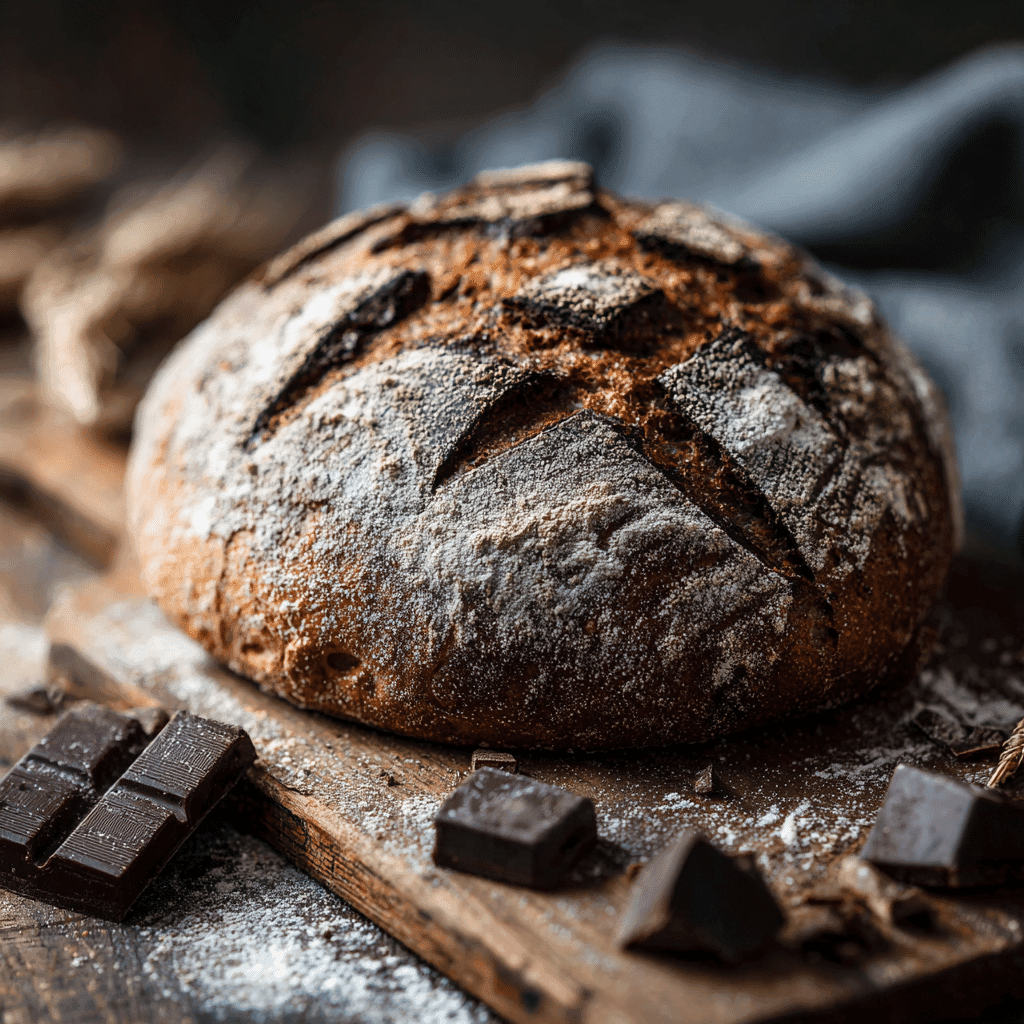Chocolate sourdough bread is the perfect marriage of deep cocoa richness and the tangy complexity of a naturally fermented loaf. It’s not just another sweet bread—it’s a bold, chewy, crusty creation that fits right in at breakfast, brunch, or even dessert. Whether you’re a seasoned sourdough lover or curious about chocolate-infused bakes, this bread delivers both comfort and sophistication. In this guide, you’ll learn the story behind the recipe, how to craft it from scratch, tips to nail fermentation, and delicious pairing ideas. Trust me, this chocolate sourdough bread will become your new baking obsession.
Table of Contents
1: The Story Behind Chocolate Sourdough Bread
Baking Across Cultures and Crumbs
The first time I tasted chocolate sourdough bread was in a tiny Berlin café, tucked away in a cobblestone alley. The loaf was dark, dense, and full of gooey dark chocolate chunks. It had that familiar sourdough tang, but every bite melted into bittersweet softness. I couldn’t stop thinking about it. Back home, I started experimenting with my own starter—the one I’d used to make crusty boules and even a version of gluten-free sourdough bread. I knew I wanted that deep chocolate flavor to shine without overwhelming the sour notes.
Inspired by memories of my grandmother’s hearty rye loaves and my own time cooking across street food stalls and bistros, I slowly developed a recipe. My starter was active, the dough was sticky, and my hands were dusted in cocoa and flour more times than I can count. But when I finally nailed the balance—soft crumb, crisp crust, rich chocolate veins—I knew this chocolate sourdough bread was something worth sharing. I started gifting loaves to friends and neighbors. Their reactions told me everything: wide eyes, second slices, and “Wait, this is sourdough?”
What Makes Chocolate Sourdough Bread Special
What sets this loaf apart is how the fermentation process complements the boldness of cocoa. Unlike sweet breads like banana zucchini bread, this recipe isn’t overly sugary. The natural yeast culture gives depth, while chunks of 70% dark chocolate provide satisfying contrast. The dough rises slowly, which enhances not only flavor but digestibility.
For bakers who already love sourdough, chocolate adds a new layer of creativity. And if you’re just starting out, this loaf is a fun, rewarding project. To explore more unique twists, check out our easy chocolate desserts or even a fruit-forward favorite like strawberry nectarine crisp.
2: Ingredients and Prep for Perfect Chocolate Sourdough Bread
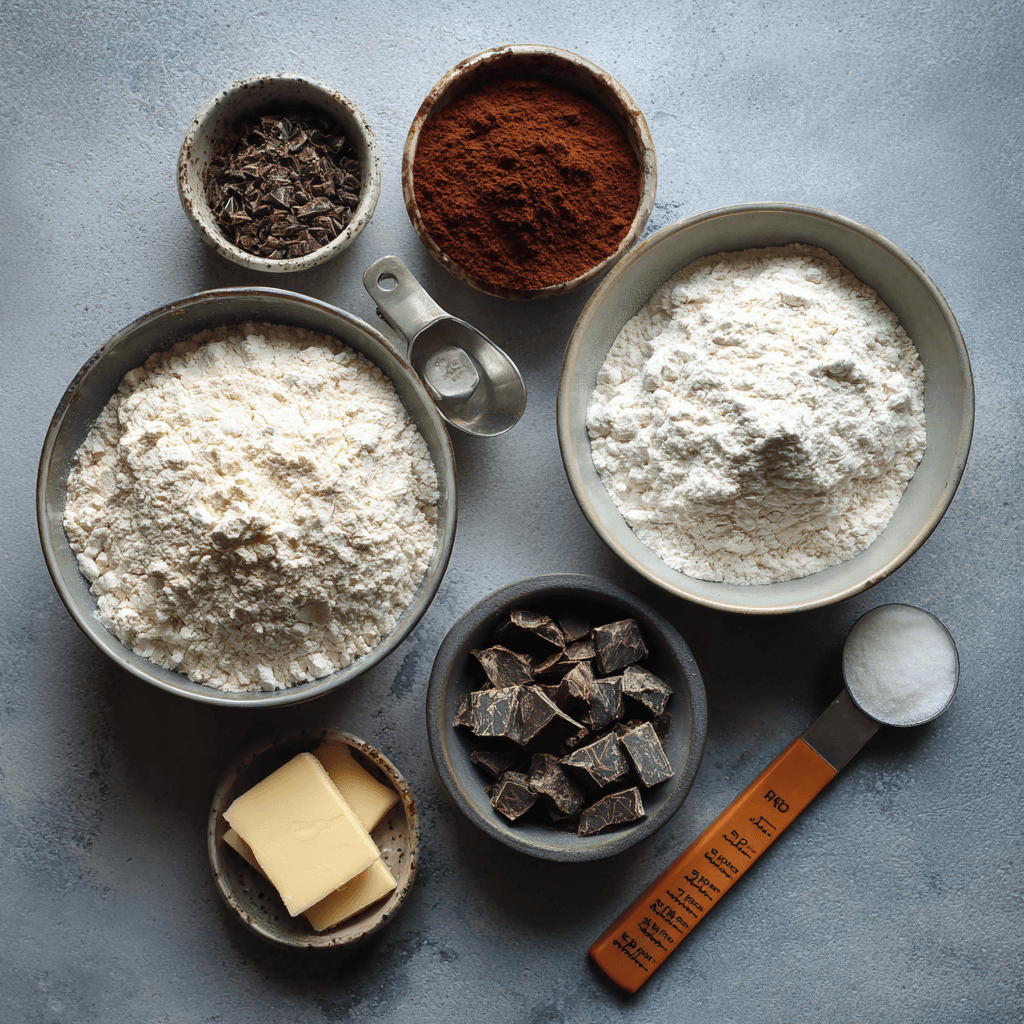
Essential Ingredients for Texture and Flavor
To create that signature blend of deep cocoa richness and chewy sourdough crumb, the right ingredients matter. You’ll need strong bread flour, an active sourdough starter, and quality dark chocolate. Cocoa powder adds a slight bitterness that balances beautifully with sweet, melted chocolate chunks. A touch of honey or maple syrup brings gentle sweetness without turning it into dessert. Some bakers like to include espresso powder or cinnamon for a richer taste.
Here’s a quick look at what you’ll need:
- Bread flour – 500g
- Water – 350g
- Ripe sourdough starter – 100g
- Salt – 10g
- Unsweetened cocoa powder – 30g
- Dark chocolate chunks (70% cocoa) – 100–150g
Optional flavor additions include orange zest, chili flakes, or even dried cherries for a fruity bite. If you enjoy layering flavors, try something inspired by our peach-forward peach bread recipe or the contrast in our peach jalapeño jam.
Understanding Fermentation: Does Chocolate Sourdough Take Longer?
Yes—chocolate sourdough bread typically takes longer to bulk ferment. The addition of cocoa and solid chocolate pieces slows down fermentation slightly. You’ll want to give it 5 to 6 hours at room temperature for the first rise. The dough should nearly double and feel airy yet elastic when gently pressed.
Be sure to perform 3 to 4 stretch-and-folds in the first few hours to strengthen the dough. After shaping, an overnight proof in the fridge enhances flavor and improves crust development. If you’ve tried soft, dense textures like our banana bread cookies, you’ll appreciate the satisfying chew this loaf delivers.
3: Baking and Flavor Variations for Chocolate Sourdough Bread
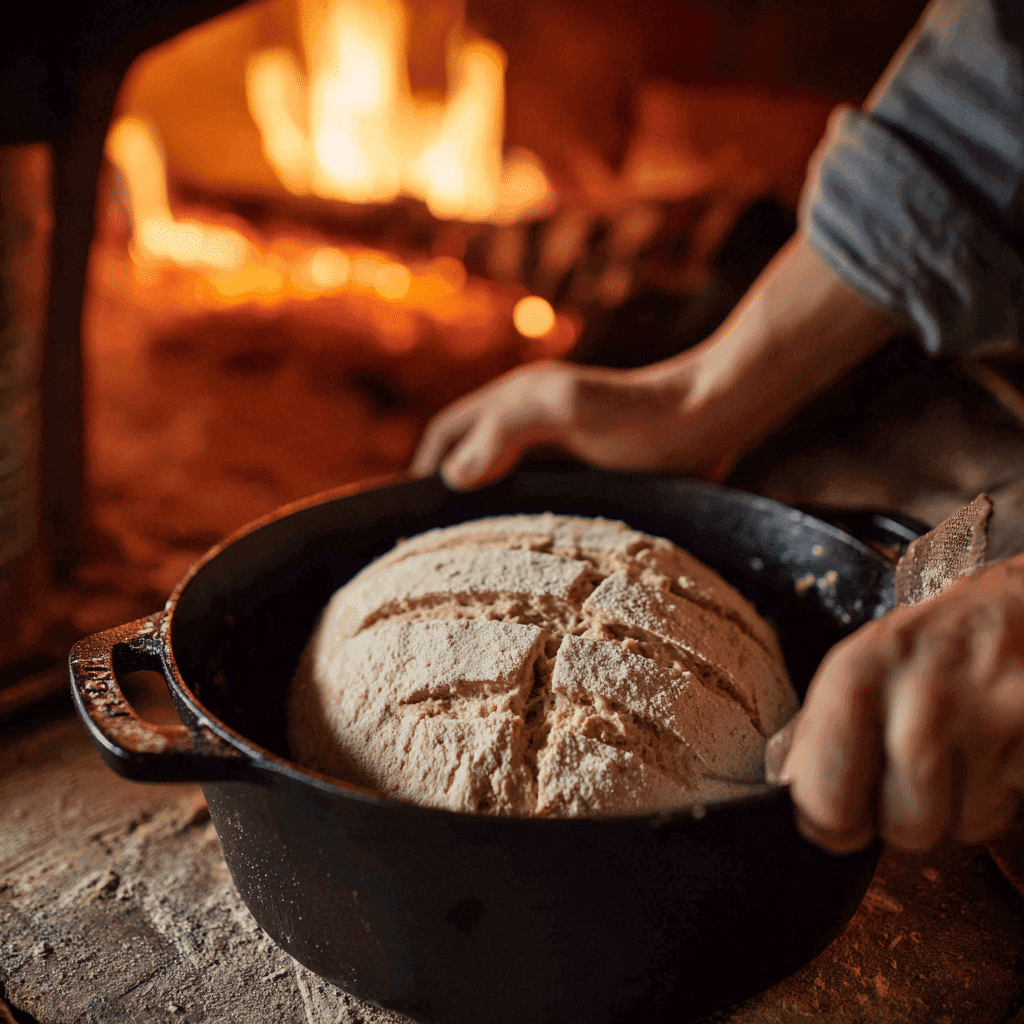
How to Bake It Right—Timing, Temperature, Texture
After cold-proofing overnight, your chocolate sourdough bread is ready to bake. Preheat your oven to 475°F (245°C) with a Dutch oven inside—this helps trap steam and create that golden, crusty exterior. Once the oven is fully heated, transfer the shaped dough onto parchment, score the top with a sharp blade, and carefully place it in the hot Dutch oven.
Bake for 20 minutes with the lid on, then remove the lid and bake another 20–25 minutes until the crust is deep brown and firm to the touch. Let the loaf cool completely before slicing—this rest time is crucial to finishing the baking inside and allowing the chocolate to set without smearing.
If you’re used to soft sweet breads like our cookies recipe low sugar, this crusty loaf will be a new and rewarding texture adventure.
Flavor Add-Ins: Take It Further Than Just Chocolate
Chocolate sourdough bread is flexible—you can get creative with flavor combos without compromising structure. Try adding:
- Orange zest for a citrus kick
- Toasted walnuts or hazelnuts for crunch
- Dried cherries or cranberries for tart contrast
- Chili flakes for a bold, spicy edge
- Espresso powder for deeper cocoa tones
These additions layer beautifully into the dough, just like we do with fruit and spice in our banana zucchini bread .
You can also dust the shaped loaf with cinnamon sugar before baking for a lightly caramelized crust. Just remember to fold in any chunks or dried fruit during the second half of bulk fermentation to avoid breaking the gluten structure.
4: Serving Chocolate Sourdough Bread — Sweet and Savory Pairings
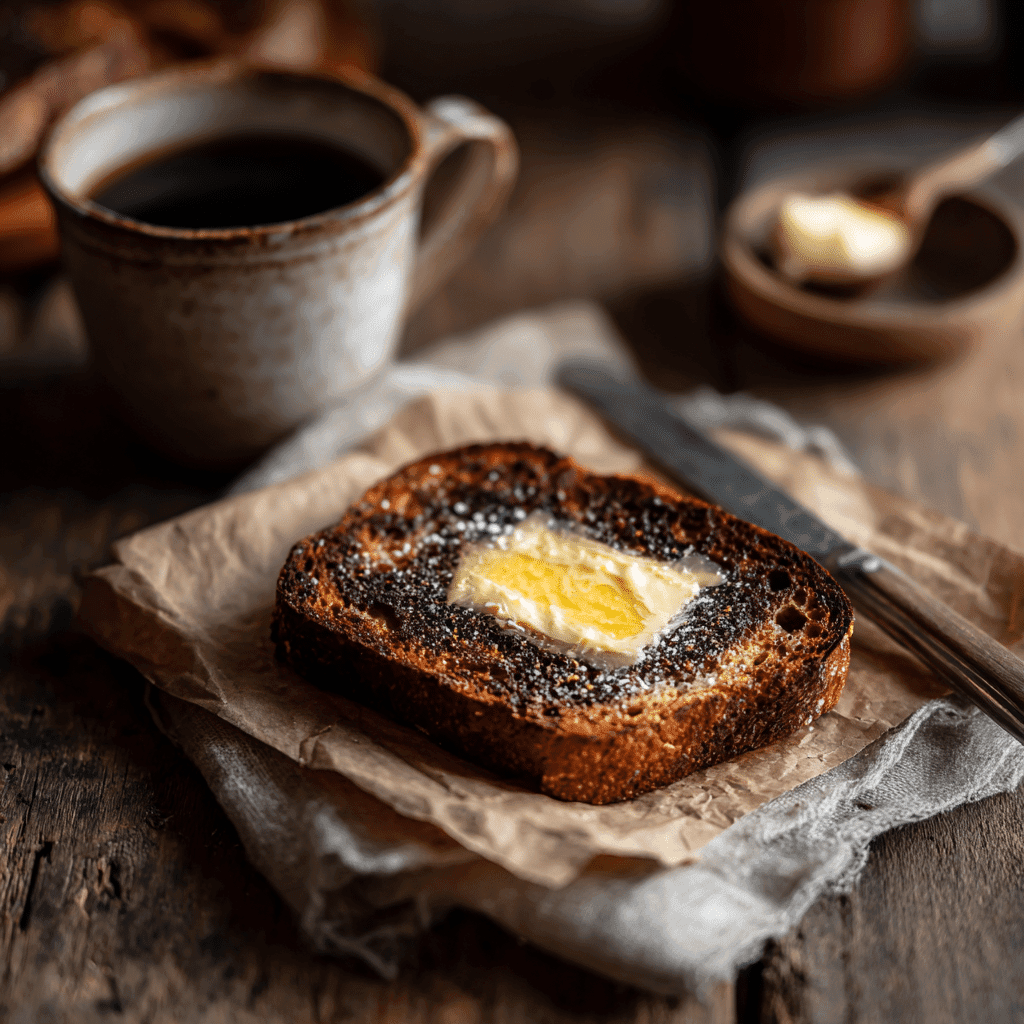
Simple, Beautiful Ways to Enjoy Every Slice
Once your chocolate sourdough bread is baked and cooled, the fun begins. You can enjoy this loaf warm, room temperature, or lightly toasted, depending on how gooey you want those chocolate chunks to be. A simple pat of salted butter is often enough to bring out the rich, earthy flavors. But if you’re feeling creative, try spreading on mascarpone, ricotta, or a flavored cream cheese. A drizzle of maple syrup or honey adds elegance without overpowering the tangy crumb.
For breakfast, serve it with Greek yogurt and fresh berries. It’s also incredible as a base for French toast—just dip slices in an egg-milk mixture, cook gently, and dust with cocoa or cinnamon sugar. Want a heartier option? Pair it with bacon or breakfast sausage for a contrast that really works.
If you’re in the mood for baking more unique bread treats, our banana zucchini bread and peach bread recipe also offer lovely, slightly sweet slices to start your day.
Unexpected but Delicious Savory Pairings
One of the best-kept secrets about chocolate sourdough bread is that it plays beautifully with savory flavors. Thinly slice it and serve alongside a charcuterie board. Sharp cheeses like aged cheddar, nutty gouda, or creamy blue cheese create a fantastic contrast with the chocolate’s richness.
Add a few dried figs, walnuts, or even a dollop of our homemade peach jalapeño jam to really make the board sing. For a luxurious snack, try a toasted slice topped with brie and a sliver of dark chocolate—simple, bold, unforgettable.
Serve it with dark coffee or a rich red wine for the full experience. And if you’re entertaining, pairing it with one of our easy chocolate desserts will leave guests seriously impressed.
for mor recipes follow me in facebook and pinterest
5: Conclusion
Chocolate sourdough bread brings together the best of both worlds: the earthy tang of fermentation and the indulgence of real dark chocolate. It’s not just a novelty loaf—it’s deeply satisfying, surprisingly versatile, and full of bold flavor. From breakfast toast to elegant pairings on a cheese board, this bread rises above expectations. Whether you’re already baking sourdough or starting fresh, this recipe invites creativity and connection in the kitchen.
With a handful of pantry staples and a bit of patience, you can turn your starter into something extraordinary. Try it once, and chances are it won’t be your last. For more ideas, don’t miss our banana zucchini bread or seasonal bakes like peach bread. Happy baking!
Does chocolate sourdough take longer to bulk ferment?
Yes, slightly. Cocoa powder and chocolate chunks can slow fermentation. Expect 5–6 hours at room temp or cold-proof overnight for best results.
Is sourdough healthier for you than regular bread?
Generally, yes. Sourdough is easier to digest due to its fermentation process. It may also cause fewer blood sugar spikes compared to commercial yeast breads.
What flavors can you add to sourdough bread?
From savory add-ins like olives and herbs to sweet options like dried fruit, nuts, citrus zest, and spices, sourdough is a blank canvas. Chocolate, cinnamon, and chili flakes work especially well in this recipe.
What is the disadvantage of sourdough bread?
Time. Sourdough requires patience, from feeding the starter to bulk fermentation. It also has a stronger flavor that might not suit every palate.
What to pair with chocolate sourdough?
Sweet options include butter, honey, or mascarpone. Savory pairings like cheese or cured meats work surprisingly well. It’s also delicious with nut butter and berries.
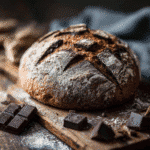
Chocolate Sourdough Bread
- Total Time: 6 hours 10 minutes (including bulk fermentation)
- Yield: 1 large loaf
Description
A bold, chewy, crusty chocolate sourdough bread—rich with cocoa and 70% dark chocolate chunks. Tangy, earthy, and deeply satisfying, perfect for breakfast or dessert.
Ingredients
- 500g bread flour
- 350g water
- 100g ripe sourdough starter
- 10g salt
- 30g unsweetened cocoa powder
- 100–150g dark chocolate chunks (70% cocoa)
- Optional: orange zest, chili flakes, dried cherries, espresso powder
Instructions
- Mix bread flour, water, starter, salt, cocoa powder, and any optional add-ins until combined.
- Cover and let rest for 30 minutes (autolyse).
- Perform 3–4 stretch-and-folds over 3 hours to strengthen dough.
- Fold in dark chocolate chunks halfway through bulk fermentation.
- Let dough bulk ferment at room temperature for 5–6 hours until nearly doubled.
- Shape into a round loaf and place into a floured banneton.
- Cover and cold-proof overnight in the fridge.
- Preheat oven to 475°F (245°C) with a Dutch oven inside.
- Transfer dough to parchment, score the top, and bake covered for 20 minutes.
- Remove lid and bake another 20–25 minutes until deep brown.
- Cool completely before slicing.
Notes
Best enjoyed with salted butter, mascarpone, or cheeses like aged cheddar or blue cheese. Also excellent toasted with berries or as French toast. Cold-proofing overnight enhances flavor and crust.
- Prep Time: 25 minutes
- Cook Time: 45 minutes
- Category: Bread
- Method: Baking
- Cuisine: Artisan

